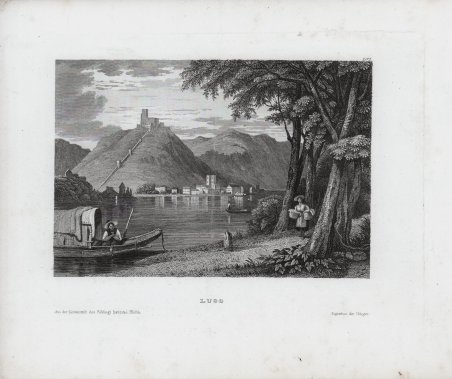Veduta tratta dal celebre ' Meyer's Universum, ' raccolta di tavole raffiguranti città e luoghi di tutto il mondo pubblicata in fascicoli a Hildburgshausen, dal Bibliographisches Institut. Quest'opera seriale molto popolare, lanciata nel 1833 da Carl Joseph Meyer, presentava incisioni di paesaggi, vedute e monumenti architettonici di tutto il mondo. La presentazione di queste immagini evocava un senso di accesso non mediato allo spettacolo visivo, ma si basava su un paradosso. Nei suoi testi Meyer aspirava a offrire ai lettori una visione inedita e di prima mano del mondo conosciuto. Allo stesso tempo, però, la sua strategia editoriale si basava su un sistema di riciclaggio transnazionale e di prestito non riconosciuto di illustrazioni da altre fonti. Lo studio Meyer ripubblicava spesso le immagini in nuove configurazioni in diverse serie, anche in versioni tradotte all'estero. Il risultato privilegiava una presentazione visiva del mondo arbitraria e decontestualizzata, nell'interesse della convenienza editoriale e dell'economicità. Carl Joseph Meyer nacque a Gotha, in Germania, e si formò come mercante a Francoforte sul Meno. Meyer operò con grande successo come editore, utilizzando un sistema di abbonamento seriale alle pubblicazioni, nuovo per l'epoca. A questo scopo fondò una società, il Bibliographisches Institut, a Gotha nel 1826. Pubblicò diverse edizioni della Bibbia, opere di letteratura classica, il mondo in immagini su incisioni in acciaio ("Meyers Universum", 1833-61, 17 volumi in 12 lingue con 80.000 abbonati in tutta Europa) e un'enciclopedia ("Das Grosse Conversations-Lexikon für die gebildeten Stände"; cfr. Meyers Konversations-Lexikon, 1839-55, 52 volumi). La sua azienda crebbe notevolmente e nel 1828 la trasferì da Gotha a Hildburghausen. Si dedicò alla cartografia, producendo molti atlanti con mappe incise su lastre d'acciaio, tra cui il Meyer Gro?er Hand-Atlas (1843-1860). Dopo la morte di Meyer nel 1856, il figlio Herrmann Julius Meyer rilevò il Bibliographisches Institut, che all'epoca era in difficoltà finanziarie. Incisione in rame, in buono stato di conservazione. View taken from ' Meyer's Universum, ' published by the Bibliographisches Institut, in Hildburgshausen. This highly popular serial work, launched in 1833 by Carl Joseph Meyer, featured engravings of notable landscapes, vedute, and architectural monuments from around the world. The work's presentation of these images evoked a sense of unmediated access to visual spectacle but was predicated on a paradox. In his texts Meyer aspired to offer readers unprecedented and first-hand views of the known world. At the same time, however, his publishing strategy was predicated on a system of transnational recycling and unacknowledged borrowing of illustrations from other sources. Meyer's firm frequently republished the images in new configurations in different series, including in translated versions abroad. The result privileged an arbitrary and decontextualized visual presentation of the world in the interest of publishing expedience and cost-effectiveness. Carl Joseph Meyer Meyer was born at Gotha, Germany, and was educated as a merchant in Frankfurt am Main. Meyer operated very successfully as a publisher, employing a system of serial subscription to publications, which was new at that time. To this end he founded a company, Bibliographisches Institut, in Gotha in 1826. It published several editions of the Bible, works of classical literature, the world in pictures on steel engravings ("Meyers Universum", 1833–61, 17 volumes in 12 languages with 80,000 subscribers all over Europe), and an encyclopaedia, ("Das Grosse Conversations-Lexikon für die gebildeten Stände" 1839–55, 52 volumes). His company grew substantially, and in 1828 he moved it from Gotha to Hildburghausen. He became involved in cartography, producing many atlases with steel-engraved maps printed from steel plates, including Meyer's Gro?er Hand-Atlas (1843-1860). After Meyer's death in 1856, his son Herrmann Julius Meyer took over the Bibliographisches Institut, which was at that time struggling financially. Copperplate, good condition. Cfr.

Scopri come utilizzare
Scopri come utilizzare

